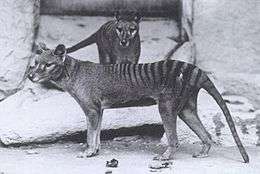Thylacinidae
Thylacinidae is an extinct family of carnivorous, superficially dog-like marsupials from the order Dasyuromorphia. The only species to survive into modern times was the thylacine (Thylacinus cynocephalus), which became extinct in 1936.
| Thylacinidae | |
|---|---|
 | |
| Thylacine | |
| Scientific classification | |
| Kingdom: | Animalia |
| Phylum: | Chordata |
| Class: | Mammalia |
| Infraclass: | Marsupialia |
| Order: | Dasyuromorphia |
| Family: | †Thylacinidae C.L. Bonaparte, 1838 |
| Genera | |
|
All extinct, see text | |
The consensus on placement of the family is with the Dasyuromorphia order, with agreement on the divergence this family and the Dasyuridae, represented by the extant quolls and Tasmanian devil Sarcophilus harrisii, remaining under consideration.
The thylacinid family was represented by two species in a synonymy published in 1982, the recently extinct Tasmanian tiger and the species Thylacinus potens, known by fossil material. Discoveries of new material, especially in well researched fossil depositions at the Riversleigh World Heritage Area, revealed a diverse array of genera and families existing during Miocene epoch. The dentition of specimens and some largely complete crania showed the development of specialist predators capable of hunting and consuming a range of vertebrate species, and like other mammalian predators, such as the canid family, could include herbivores larger than themselves. An assessment of the size range of the species has provided evidence of animals occupying a greater number of trophic levels and challenged the conception of the dominance of reptilians as large hyper-carnivorous predators on the Australia continent.[1]
The consensus of authors prior to 1982 was that the thylacinid family were related to the borhyaenoids, a group of South American predators, also extinct, that exhibited many similar characteristics of dentition. A review published in 1982 compared the skeletal structure of these groups, concluding the tarsal bones show greater affinity with the dasyurmorphs, strongly supporting the later theory that any dental similarities emerged independently.[2]
Another family, the Thylacoleonidae, were also large carnivorous marsupials, but allied to the order Vombatiformes and assumed to have also evolutionarily converged as predators of large herbivores.
Genera
Family Thylacinidae, extinct
- Genus Badjcinus Muirhead & Wroe, 1998[3]
- Badjcinus turnbulli (Late Oligocene)
- Genus Maximucinus Wroe, 2001[1]
- Maximucinus muirheadae (Middle Miocene)
- Genus Muribacinus Wroe, 1995[4]
- Muribacinus gadiyuli (Middle Miocene)
- Genus Mutpuracinus Murray & Megirian, 2000[5]
- Mutpuracinus archibaldi (Middle Miocene)
- Genus Ngamalacinus Muirhead, 1997[6]
- Ngamalacinus timmulvaneyi Early Miocene Riversleigh fauna
- Genus Nimbacinus Muirhead & Archer, 1990[7]
- Nimbacinus dicksoni (Late Oligocene — Early Miocene)
- Nimbacinus richi (Middle Miocene)
- Genus Thylacinus Temminck, 1824
- Thylacinus cynocephalus, also known as the thylacine (Early Pliocene to Holocene)
- Thylacinus macknessi (Late Oligocene — Early Miocene)
- Thylacinus megiriani (Late Miocene)
- Thylacinus potens (Early Miocene)
- Thylacinus yorkellus
- Genus Tyarrpecinus Murray & Megirian, 2000[5]
- Tyarrpecinus rothi (Late Miocene)
- Genus Wabulacinus Muirhead, 1997[6]
- Wabulacinus ridei Early Miocene Riversleigh fauna
References
- Wroe, S. (2001). "Maximucinus muirheadae, gen. et sp. nov. (Thylacinidae : Marsupialia), from the Miocene of Riversleigh, north-western Queensland, with estimates of body weights for fossil thylacinids". Australian Journal of Zoology. 49 (6): 603. doi:10.1071/ZO01044.
- Long, J.A.; Archer, M. (2002). Prehistoric Mammals of Australia and New Guinea: One Hundred Million Years of Evolution. UNSW Press. p. 60. ISBN 9780868404356.
- Muirhead, Jeanette; Wroe, Stephen (September 1998). "A New Genus and Species, Badjcinus turnbulli (Thylacinidae: Marsupialia), from the Late-Oligocene of Riversleigh, Northern Australia, and an Investigation of Thylacinid Phylogeny". Journal of Vertebrate Paleontology. 18 (3): 612–626. doi:10.1080/02724634.1998.10011088.
- Wroe, Stephen (1995). "Muribacinus gadiyuli (Thylacinidae: Marsupialia), a very plesiomorphic thylacinid from the Miocene of Riversleigh, northwestern Queensland, and the problem of paraphyly for the Dasyuridae (Marsupialia)". Journal of Paleontology. 70 (6): 1032–1044. doi:10.1017/S0022336000038737.
- Murray, P.; Megirian, D. (2000). "Two New Genera and Three New Species of Thylacinidae (Marsupialia) from the Miocene of the Northern Territory, Australia". The Beagle : Occasional Papers of the Northern Territory Museum of Arts and Sciences. 16: 145–162.
- Muirhead, J. (1997). "Two new early Miocene thylacines from Riversleigh, northwestern Queensland". Memoirs of the Queensland Museum. 41: 367–377.
- Muirhead, J.; Archer, M. (1990). "Nimbacinus dicksoni, a plesiomorphic thylacine (Marsupialia: Thylacinidae) from Tertiary deposits of Queensland and the Northern Territory". Memoirs of the Queensland Museum. 28: 203–221.